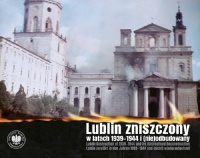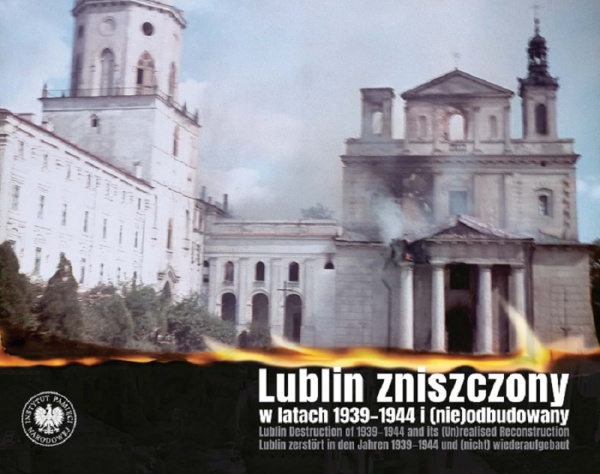Opis książki:
Publikacja w ramach Oddziałowego Projektu Badawczego „Zniszczenia wojenne Lublina w latach 1939-1944”.
Celem albumu jest ukazanie skali destrukcji dokonanej przede wszystkim przez Niemców w okresie II wojny światowej, wskazanie zmian zaszłych w krajobrazie Lublina w ich wyniku, a także dokonanie porównania wyglądu wybranych obiektów i miejsc zniszczonych we wrześniu 1939 r., w trakcie wysiedleń Wieniawy, w wyniku likwidacji lubelskiej dzielnicy żydowskiej, sowieckiego bombardowania w maju 1944 r. oraz w czasie walk o miasto w lipcu tego roku z ich stanem pierwotnym oraz dzisiejszym.
Dlatego konstrukcja albumu opiera się na porównawczym układzie fotografii ułożonych w cyklach czasowych: przed wojną – w trakcie wojny – tuż po wojnie – współcześnie. Taki zabieg pozwala czytelnikowi odbyć wizualną podróż w czasie i przestrzeni Lublina. Album podzielono na rozdziały odpowiadające poszczególnym etapom zniszczeń miasta. Główny podział terytorialny obejmuje trzy charakterystyczne obszary Lublina: Wieniawę, Stare Miasto oraz teren dawnego getta (Podzamcze), obszar Krakowskiego Przedmieścia i Placu Wolności. W ramach tego podziału zdjęcia ułożono chronologicznie, przypisując je do czterech kluczowych momentów historycznych: bombardowań z 1939 r., wysiedleń z Wieniawy, likwidacji getta w 1942 r. i walk w lipcu 1944 r. Przyjęty układ pozwala śledzić odrębną historię każdej dzielnicy, a zarazem wpisuje ją w szerszy kontekst wydarzeń wojennych. Zestawienie fotografii sprzed zniszczeń z obrazami ruin, a następnie ze stanem (nie)odbudowanym uwypukla skalę strat. Przez bezpośrednie porównanie „dawniej i dziś” odbiorca lepiej rozumie konsekwencje wojny dla całego miasta. Może dostrzec zarówno bezpowrotną utratę pewnych obiektów, jak i ciągłość miejskiej tkanki tam, gdzie udało się ją odbudować. Kryterium porządkowania materiału była też symbolika. Preferowane były kadry miejsc i obiektów o znaczeniu historycznym, np. katedra, synagogi, rynek Starego Miasta. Takie fotografie niosą ze sobą głębszy przekaz, stając się ikonami pamięci zbiorowej (jak obraz zrujnowanej katedry czy wypalonych kamienic na Krakowskim Przedmieściu). Kluczem koncepcji albumu jest idea porównania i narracji wizualnej. Każdy zestaw zdjęć przedstawia kontinuum historii miejsca: od stanu wyjściowego (pierwotnego) przez moment katastrofy aż po (nie)odbudowę i stan obecny. Taka struktura umożliwia czytelnikowi nie tylko obserwację zmian, ale i ich zrozumienie. Zdjęcia „opowiadają” losy miasta bardziej wymownie niż słowa. Album staje się przez to czymś więcej niż katalogiem fotografii: tworzy spójną opowieść o niszczeniu i odradzaniu się Lublina, służy zarazem dokumentacji, edukacji i refleksji.
* * *
The aim of the album is: (I) Presenting the scale of destruction caused primarily by the Germans during the Second World War; (II) Showing the changes in Lublin’s landscape resulting from this destruction; (III) and, as far as the available source material allows, comparing the appearance of selected sites and buildings affected by the devastation of September 1939, the displacement of Wieniawa’s residents, the liquidation of the Jewish district in Lublin, the Soviet bombing of May 1944, and the fighting for the city in July of that year, with their original condition and their state today.
Therefore, the composition of the album is based on a comparative layout of photographs, arranged into chronological sequences: before the war – during the war – immediately after the war – present day. This approach allows the reader to embark on a visual journey through the time and space of Lublin. The album has been divided into chapters corresponding to successive stages of the city’s destruction. The main geographical division encompasses three characteristic areas of Lublin: Wieniawa, the Old Town, and the area of the former ghetto (Podzamcze), along with Krakowskie Przedmieście Street and Wolności Square. Within this framework, the photographs are arranged chronologically and assigned to four key historical moments: the bombings of 1939, the displacement of Wieniawa’s inhabitants, the liquidation of the ghetto in 1942, and the fighting of July 1944. The adopted structure makes it possible to follow the individual story of each district while simultaneously embedding it within the broader context of wartime events. The juxtaposition of photographs from before the destruction with images of ruins and then with the (un)reconstructed state highlights the scale of the devastation. Through a direct comparison between ‘the past and present,’ the viewer gains a deeper understanding of the war’s consequences for the entire city, perceiving both the irreversible disappearance of certain buildings and the continuity of the urban fabric where reconstruction was successful. The photographs included in the album show, among others, the bombed streets of the Old Town in September 1939, destroyed buildings of depopulated district of Wieniawa, the deserted ruins of the former Jewish district, and the final wartime devastation during the fighting of July 1944.
Symbolism was also a criterion for organising the material. Emphasis was placed on photographs of locations and buildings of historical significance, such as the cathedral, synagogues, and the Old Town market square. Such photographs convey a deeper meaning, becoming icons of collective memory (e.g. images of the ruined cathedral, or the burned-out tenement houses on Krakowskie Przedmieście). At the heart of the album’s concept lies the idea of comparison and visual storytelling. Each set of photographs presents a continuum in the history of a given place: from its original state, through the moment of catastrophe, to its (un)realised reconstruction and present condition. This structure enables the viewer not only to observe the changes, but to understand them. The photographs ‘tell’ the city’s story more powerfully than words ever could. As a result, the album becomes more just than a catalogue of images: it forms a coherent narrative about the destruction and renewal of Lublin, serving simultaneously as tool for documentation, education, and reflection.
* * *
Der Zweck dieses Albums ist es, (I) das Ausmaß der Zerstörungen zu zeigen, die vor allem durch die Deutschen während des Zweiten Weltkriegs verursacht wurden; (II) die dadurch bewirkten Veränderungen im Stadtbild Lublins sichtbar zu machen; sowie (III) – soweit Quellenmaterial verfügbar ist – das Erscheinungsbild ausgewählter Orte und Bauwerke zu vergleichen: den Zustand infolge von Zerstörungen im September 1939, der Aussiedlung von Wieniawa, der Liquidation des jüdischen Viertels 1942, des sowjetischen Bombardements im Mai 1944 und der Kämpfe um die Stadt im Juli desselben Jahres, mit ihrem heutigen Erscheinungsbild.
Die Konzeption des Albums beruht auf dem Prinzip des Vergleichs. Fotografien sind in zeitlichen Zyklen angeordnet: vor dem Krieg – während des Krieges – unmittelbar nach dem Krieg – heute. Auf diese Weise unternimmt der Betrachter eine visuelle Reise durch Zeit und Raum Lublins. Die Kapitel des Albums entsprechen einzelnen Etappen der Zerstörung und Wiedergeburt der Stadt. Die Hauptgliederung umfasst drei markante Bereiche: Wieniawa, die Altstadt mit dem Gelände des ehemaligen Ghettos (Podzamcze) sowie Krakowskie Przedmieście mit dem Plac Wolności. Innerhalb dieser Struktur sind die Aufnahmen chronologisch geordnet und vier entscheidenden Momenten zugeordnet: den Bombardierungen von 1939, den Aussiedlungen aus Wieniawa, der Liquidation des Ghettos 1942 und den Kämpfen im Juli 1944. Dadurch lässt sich die Geschichte jedes Stadtteils gesondert verfolgen und zugleich in den Gesamtzusammenhang der Kriegsgeschehnisse einbetten.
Die Gegenüberstellung von Aufnahmen aus der Vorkriegszeit, Bildern der Zerstörung und des (Nicht-)Wiederaufbaus unterstreicht eindrücklich das Ausmaß der Verluste. Durch den Vergleich von „damals und heute“ wird deutlich, welche Objekte unwiederbringlich verloren gingen und wo das städtische Gefüge erhalten oder rekonstruiert werden konnte. Die Fotografien zeigen unter anderem die bombardierten Straßen der Altstadt im September 1939, die zerstörten Häuser des geräumten Wieniawa, die Ruinen des ehemaligen jüdischen Viertels und die letzten Kriegsschäden während der Kämpfe im Juli 1944.
Bei der Auswahl spielte auch die Symbolik eine Rolle. Bevorzugt wurden Orte und Gebäude mit geschichtlicher Bedeutung, etwa die Kathedrale, Synagogen oder der Marktplatz der Altstadt. Solche Aufnahmen entfalten eine besondere Wirkung und werden zu Ikonen des kollektiven Gedächtnisses – wie das Bild der zerstörten Kathedrale oder der ausgebrannten Häuser am Krakowskie Przedmieście.
Das Leitmotiv des Albums ist der visuelle Vergleich als Form der Erzählung. Jede Bilderserie zeigt das Kontinuum eines Ortes: vom ursprünglichen Zustand über die Katastrophe bis hin zur (Nicht-)Wiederherstellung und zum heutigen Erscheinungsbild. Diese Struktur ermöglicht nicht nur die Beobachtung, sondern auch das tiefere Verständnis der Veränderungen. Die Bilder „erzählen“ die Geschichte Lublins eindringlicher als Worte. So wird das Album mehr als ein bloßer Bildkatalog: Es entsteht eine zusammenhängende Erzählung über Zerstörung und Wiedergeburt der Stadt und dient zugleich der Dokumentation, der Bildung und der Reflexion.
Książka "Lublin zniszczony w latach 1939-1944 i (nie)odbudowany; Lublin Destruction of 1939-1944 and its (Un)realised Reconstruction; Lublin zerstört in den Jahren 1939-1944 und (nicht) wiederaufgebaut" - Jacek Wołoszyn (red.), Patrycja Gustaw (red.) - oprawa twarda - Wydawnictwo Instytut Pamięci Narodowej, IPN. Książka posiada 192 stron i została wydana w 2025 r. Cena 24.50 zł. Zapraszamy na zakupy! Zapewniamy szybką realizację zamówienia.

 Spis treści - PDF
Spis treści - PDF